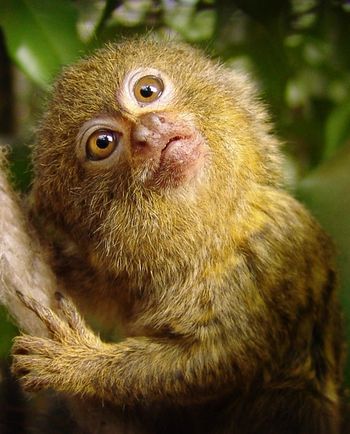Monkey

The pygmy marmoset of South America is the world's smallest true monkey, generally up to about six inches (15 centimetres) long excluding the tail, which is can be up to 7.9 inches (20 centimetres).
Monkeys are a group of primates found in both the "New" and the "Old" World. The term "monkey" is actually a laypersons term for any one of the generally small-bodied and often distantly related primates that do not fall into the classification of prosimians or the generally larger bodied apes and humans. There are two basic types of monkeys - platyrrhines and catarrhines.[1][2] South American monkeys are known as platyrrhines and differ substantially from the catarrhines monkeys, having evolved largely in isolation.[1][2]
Platyrrhine monkeys
The name platyrrhine is derived as a descriptive term of the monkeys' faces, since South American monkeys have broad, flat noses. All platyrrhine monkeys are small - the largest is only around 10kg.[1] They also exhibit many primitive dental and skeletal features including having three pre-molars in each side of their mandible and maxilla - thus they have a total of twelve premolars.[2]
All platyrrhines have a tail of some sort and five genera have prehensile tails.[1] The most well known of the prehensile-tailed monkeys is probably the spider monkey. Interestingly, the spider monkey has no thumb.[1]
Catarrhine monkeys
Catarrhines monkeys are "Old World Monkeys" and all fall under the Superfamily Cercopithecidae.[2] They have narrow noses, eight pre-molars and none have prehensile tails.[1] There are two Subfamilies within the Superfamily - Cercopithecinae and Colobinae.[2] There are approximately sixty species of cercopithicus monkey and about forty species of colobus monkey.